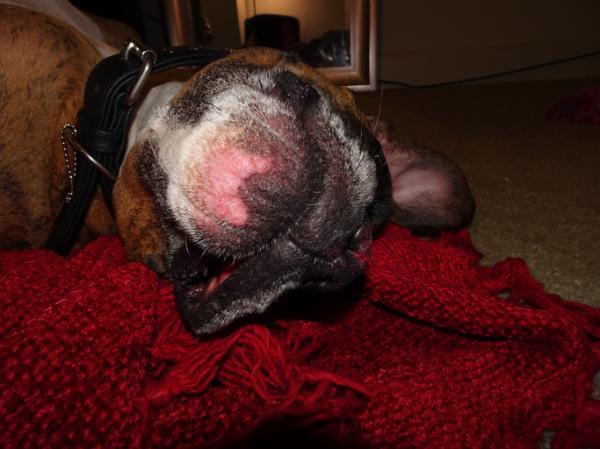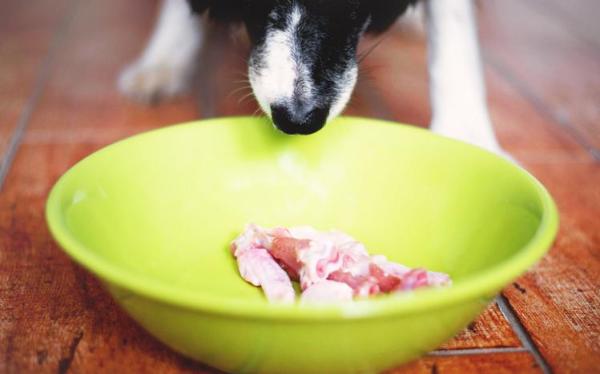Dog Food Allergies - Symptoms, Causes and Treatment



See files for Dogs
Food allergies in dogs, which must be differentiated from food intolerance in dogs, can occur in any dogs of any age or breed. The most common allergy in dog symptoms include itchy skin and dermatitis. Offering your dog a diet appropriate to its allergies is key in making sure it lives a happy and healthy life.
For more about the symptoms, treatment, home remedies and correct diet for dogs with food allergies, keep reading here at AnimalWised. If you suspect that your dog is suffering from a food allergy, make sure to consult a veterinarian as soon as possible.
Dog food allergies: symptoms
An allergy refers to a hypersensitive reaction to a substance, which, in principle, should not be dangerous to an organism. If, however, the immune system considers the substance a threat, this is when it reacts and an allergy occurs. A dog must be exposed to an allergen one or more times in order for the reaction to be triggered. Therefore, allergies occur more commonly in dogs that have eaten the same diet for a long period of time.
Many assume that the first sign of food allergies in dogs would be digestive, however, this is not the case. The most characteristic sign of food allergies in dogs is actually itching and scratching. Food allergies can appear in dogs of all ages and without seasonal pattern.
Foods most related to allergic reactions in dogs include meats, milk, eggs, fish, cereals or soy. Now, when it comes to food allergies in dogs, we need to distinguish its difference to food intolerance, which is different.
Symptoms of food allergy in dogs
So, how does a food allergy manifested in dogs? Food allergy related dermatitis is one of the main symptoms of food allergies in dogs. This disorder causes skin redness, intense itching, small red bumps and wounds on the skin due, partly due to scratching. Generally, this skin inflammation appears on the lower part of the body, the ears (resulting in Otitis), the feet and the back of the legs.
Food allergy diarrhea, however, is incredibly rare. A rapid digestive transit or diarrhea in dogs usually only occurs as a result of food intolerance in dogs. Therefore, if you suspect that your dog is suffering from a food allergy, you will need to consult a veterinarian in order to make sure it is not, in fact, caused by a food intolerance.
Symptoms of food intolerance in dogs
As we have just seen, canine intolerance to food and canine allergy to food are two completely different conditions, therefore, they also develop different symptoms. A dog with intolerance to food will develop diarrhea and / or vomiting, accompanied by abdominal pain. A dog with a food allergy, however, will show the above mentioned signs of dermatitis. For more, we recommend reading our article about the symptoms of treatment of food intolerance in dogs.

Dog food allergy test
In order to diagnose a food allergy in dogs, a veterinarian will perform a dog food allergy test, otherwise referred to as a hypoallergenic diet test. This test consists of offering the animal an elimination diet, whereby certain foods are eliminated from a diet to test and identify what is causing the allergy (or whether a dog will suffer from allergy symptoms on a baseline diet). There are specific hypoallergenic feeds which can be bought to form a baseline diet. These foods are formulated with hydrolyzed proteins, meaning that the proteins have been broken down into smaller fragments through which the organism cannot react. If allergy symptoms improve with this change in diet, your dog will be diagnosed with a food allergy.
One also carry out an elimination diet with natural foods. This method is in fact easier than the latter, especially when trying to target the specific foods which are triggering the allergic reaction. This change of diet, however, should always be performed under veterinarian supervision.
Lastly, a veterinarian may also opt for a skin allergy test. For more, we recommend reading our article where we discuss homeopathy for dogs with allergies.

Dog food allergy: treatment
Food allergies in dogs cannot be cured, however, its symptoms can be avoided. Avoiding the flare up of allergy symptoms in dogs means preventing a dog from eating the food to which it is allergic. Treatment requires finding the food or foods which are causing the allergy and eliminating it from a dog’s diet entirely.
To do this, we recommend offering your dog the already mentioned baseline diet for about 8-10 weeks. After this time, slowly and one by one, add additional foods from your dog’s previous diet. The minute you notice a reaction to an added food, one can conclude that that is the food to avoid. This too should be performed under the guidance of a veterinarian.
Drugs can also sometimes be prescribed if a dog’s scratching has caused serious dermatological problems. The objective here is to control itching, reduce inflammation or treat infections.
Antihistamine for dogs
Allergic reactions in dogs are produced by a release of histamine. For this reason, a veterinarian may include antihistamine drugs in your dog’s treatment. Antihistamine for dogs are generally only prescribed when there is evident itching and dermatitis.
There are several types of antihistamines for dogs on the market. It is a veterinarian's job to prescribe the most appropriate option and dose. You should never offer your dog antihistamine drugs for humans. In addition, Antihistamines are only prescribed when there are evident symptoms. In some cases, a veterinarian may also prescribe Corticosteroids.
Dog food allergy: homemade diet
When it comes to allergies in dogs, it is possible to resort to a homemade diet for dogs. This option allows us the option to control the foods which our dog will ingest, avoiding additives or specific ingredients. This diet should be balanced and formed with the help of a veterinarian. In addition, it must only include ingredients that a dog hasn’t yet consumed. This is necessary when it comes to avoiding the allergen.
One of the most recommended diet for dogs with food allergies is a BARF diet. The BARF diet for dogs is an all raw diet that doesn’t include conservatives, cereals or wheat. For more about the best homemade diet for dogs, we recommend reading our article where we offer a great natural diet for dogs.

Dog food allergy: home remedies
Now, if, for whatever reason, your dog doesn’t or shouldn’t eat a homemade diet, there are hypoallergenic dog foods available to buy from your local pet store.
In general, these products are made with ingredients that produce a lower percentage of allergies in dogs, in addition to avoiding artificial colorants or flavorings.
This article is purely informative. AnimalWised does not have the authority to prescribe any veterinary treatment or create a diagnosis. We invite you to take your pet to the veterinarian if they are suffering from any condition or pain.
If you want to read similar articles to Dog Food Allergies - Symptoms, Causes and Treatment, we recommend you visit our Other health problems category.








